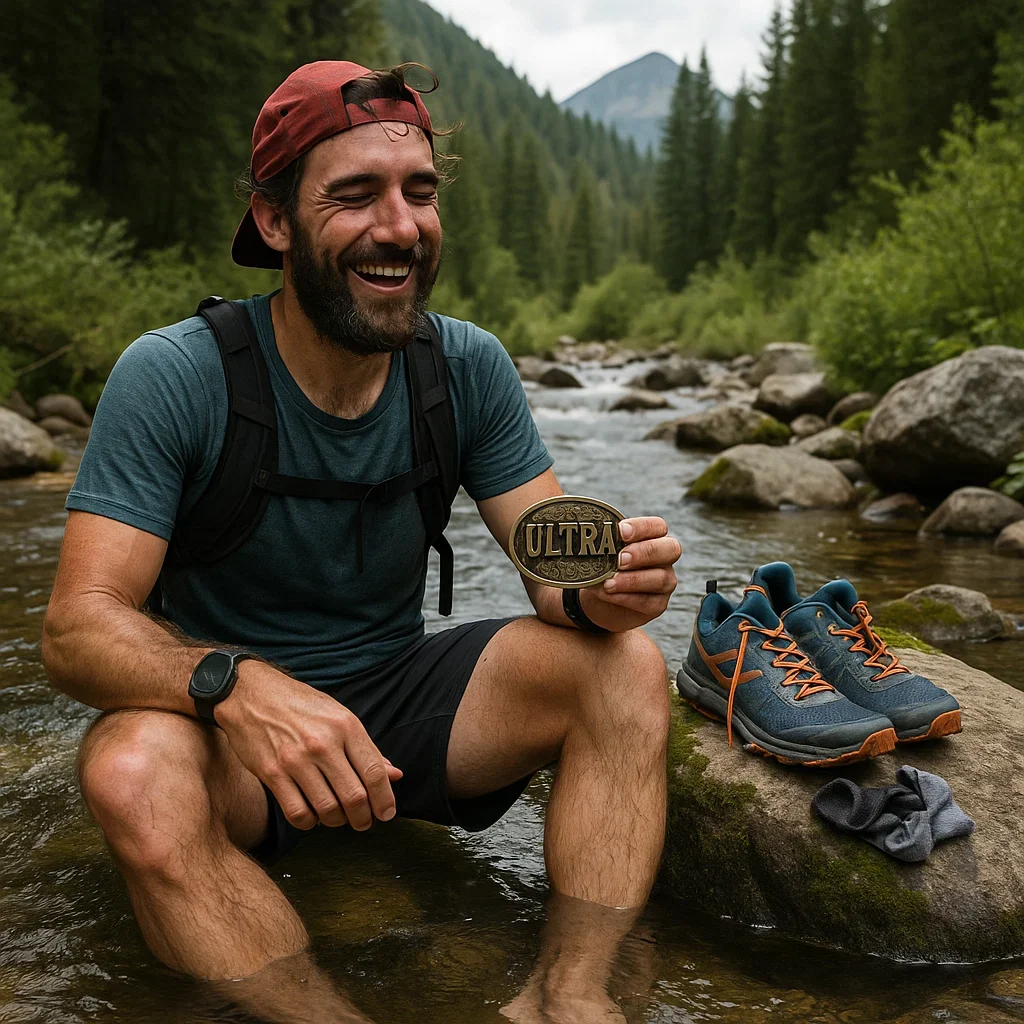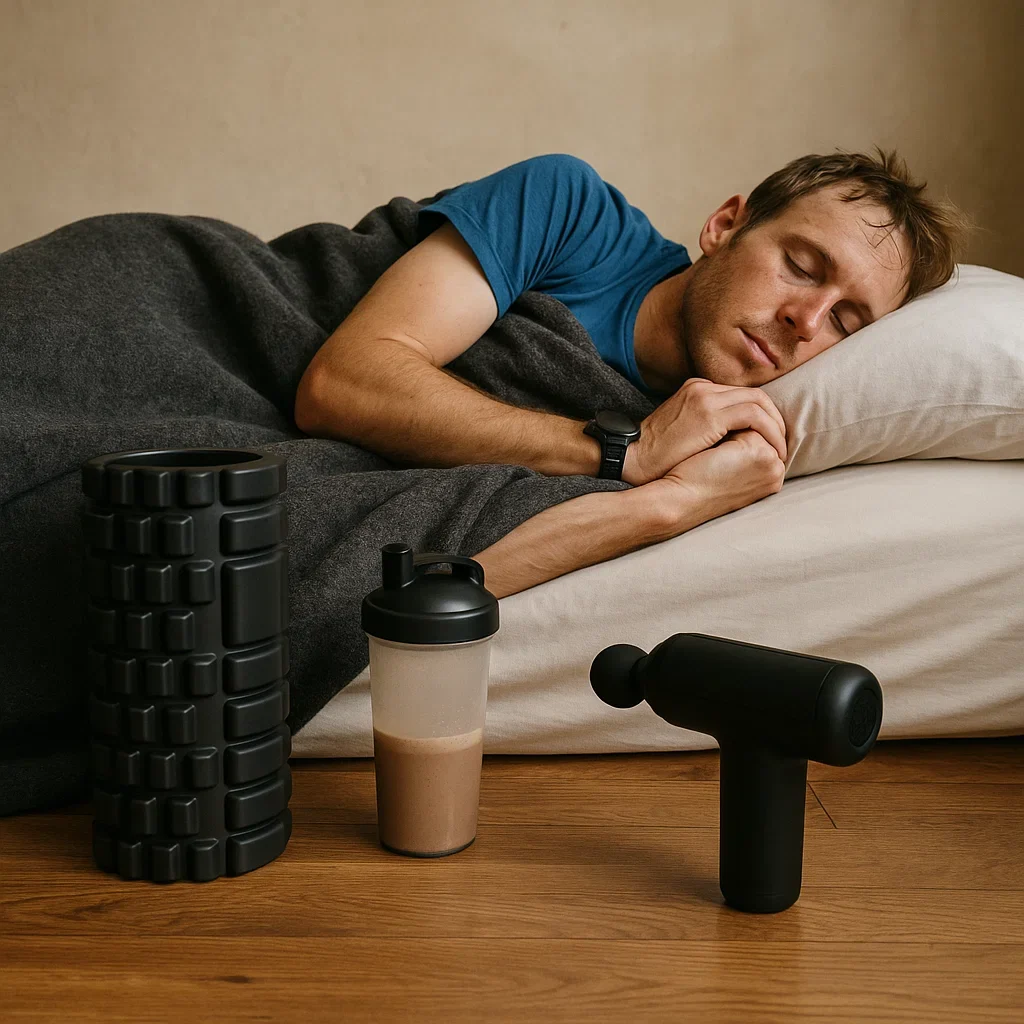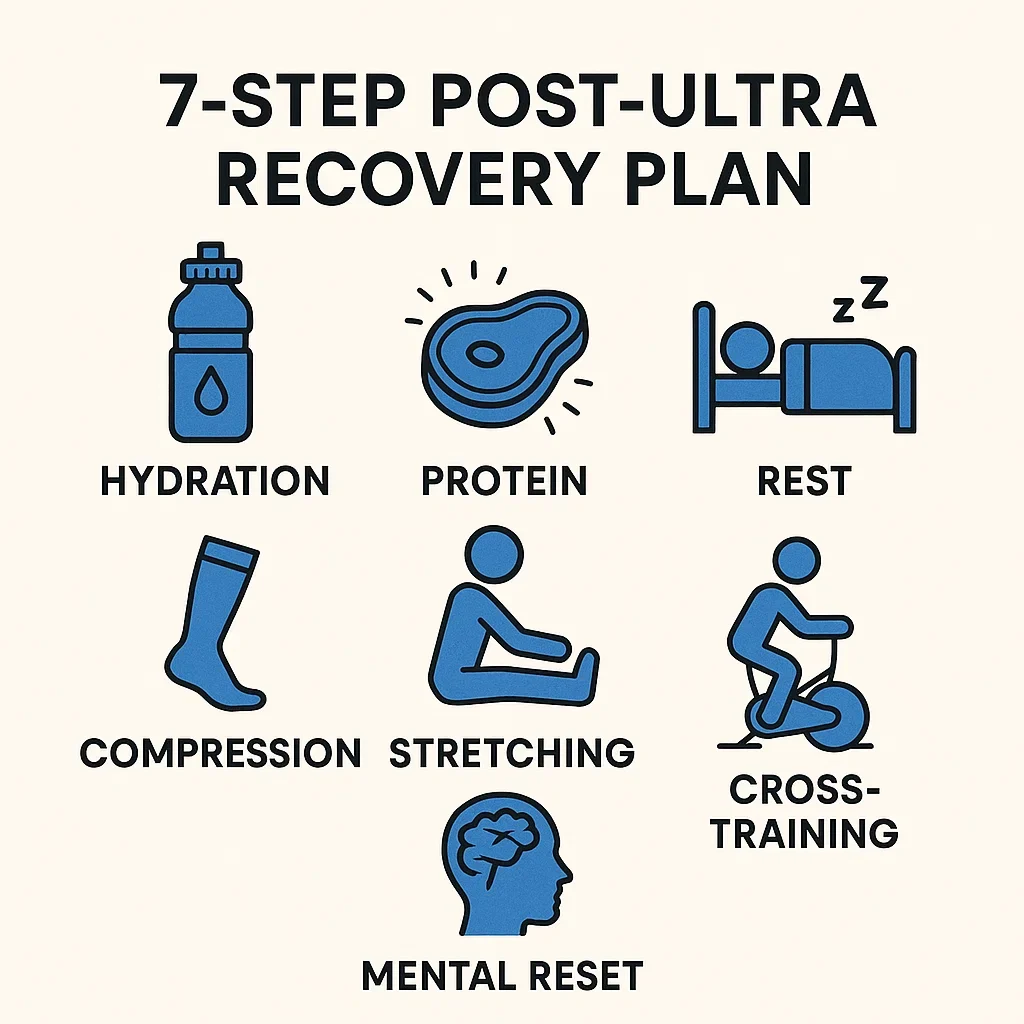Crossing the finish line of a 100-mile ultramarathon is a monumental achievement — but your race isn’t truly over when you stop your watch. What happens after you finish is just as important as every mile you ran.
Whether you sprinted to the tape or stumbled in at cutoff, your body and mind have just endured something extraordinary. Now it’s time to recover, not just rest. A well-structured post ultramarathon recovery plan helps prevent injury, speeds up healing, and ensures you return stronger — not just back to baseline.
🎯 What this guide covers:
We’ll walk you through a science-backed, experience-driven 7-step recovery framework — from the critical first hour after finishing to the weeks that follow. You’ll learn:
- How to handle that first shaky hour post-finish without stiffening up
- What to eat, drink, and avoid in the first 24 hours
- When and how to start moving again (hint: not too soon)
- Mental recovery strategies for post-race blues
- Long-term rebuilding for your next training block
Whether you’re basking in the afterglow of your first 100-miler or licking your wounds from a tough finish, this is your roadmap back to balance. Because finishing a race is epic — but recovering like a pro is what makes you unstoppable.
⏱️ Step 1: The First Hour After Finishing
So you’ve crossed the finish line — maybe in tears, maybe in triumph, maybe both. 🎖️ But here’s what most runners overlook: the first 60 minutes after an ultramarathon are critical for jumpstarting recovery and avoiding a full-body meltdown.
🧍♂️ Don’t Sit Down Just Yet
Tempting as it may be to collapse into a chair or lie flat on the grass, don’t sit still for too long right away. Your muscles are still warm, your blood flow elevated, and your joints forgiving — for now. Sitting for extended periods can cause sudden stiffness, blood pooling, and delayed cramping.
✅ Instead:
- Keep walking lightly around the finish area for 5–15 minutes
- Do gentle ankle/hip circles to prevent joint lock-up
- Change into dry, warm clothes as soon as possible
🧠 Pro tip: Bring a “recovery bag” with fresh socks, slides, a warm top, and your go-to electrolyte drink.
🥤 Start Rehydrating — Electrolytes First
After hours of sweating, your body isn’t just low on fluids — it’s imbalanced in sodium, potassium, and magnesium. Even if you’re not thirsty, start sipping small amounts of an electrolyte-rich drink within the first 15–30 minutes.
🔁 Avoid plain water only: it can dilute your electrolyte levels further and increase risk of hyponatremia.
💡 Better Options:
- Salted broth or soup
- Electrolyte tablets (like SaltStick or Precision Hydration)
- Coconut water with added salt
🍫 Fuel Up With Protein + Carbs
Your muscles are starving. You’ve just spent 20–36 hours in a catabolic state — meaning you were breaking down more than building up. Within the first 30–60 minutes, aim to consume:
- 20–30g of protein (whey, plant-based, or recovery shake)
- 40–60g of carbs (banana, dates, energy bar, rice ball)
🧃 Liquid calories are often easier to handle at this stage — a recovery drink may go down better than a full meal.
🧘♀️ Avoid Aggressive Stretching or Massage
Your muscles are inflamed and micro-damaged. While light mobility or yoga can help in the coming days, now is not the time for deep stretching or sports massage. These can worsen muscle fiber damage or delay healing.
Instead:
- Elevate your legs briefly if swelling is visible
- Sit or lie down with gentle diaphragmatic breathing
- Use compression gear if it works for you
🎒 Final Tip: Don’t Drive Yourself
If you’ve finished a 100-miler solo and think you’re okay to drive — think again. Fatigue, impaired cognition, and delayed reaction times are real. Arrange transport or rest several hours before hitting the road.

🌙 Step 2: The First 24 Hours – Rest, Repair & React Wisely
The clock is ticking — not for your pace anymore, but for healing. What you do in the first day post-ultra can accelerate recovery or set you up for prolonged soreness, fatigue, and even illness.
Let’s break it down hour-by-hour:
🛌 Prioritize Sleep (Even If You’re Too Wired)
You might feel too hyped or sore to sleep immediately, especially after a caffeine-fueled final push. But deep, uninterrupted sleep is the most powerful recovery tool you have. Aim for:
- At least 9–10 hours of nighttime sleep
- A short nap during the day if possible
- Minimized screen time and blue light before bed
💤 If you can’t sleep well, try magnesium (glycinate or threonate), herbal tea, or white noise.
💢 Expect Soreness — But Know What’s Normal
DOMS (Delayed Onset Muscle Soreness) usually peaks between 24–48 hours after the race. You’ll likely feel:
- Tender quads, hamstrings, and calves
- Foot arch fatigue or mild swelling
- General stiffness when standing up
✅ Normal: Walking like a penguin
🚨 Not normal: Sharp localized pain, extreme swelling, or dark brown urine (possible rhabdo — seek medical attention immediately)
💦 Keep Hydrating — Urine Is Your Guide
Your body might still be catching up on hydration. If your urine is:
- Dark yellow or brown → drink more fluids
- Clear and frequent → you’re back in balance
Stick with electrolyte-enhanced drinks, broth, or mineral water (like Kızılay Erzincan, if you’re a mineral nerd like us 🧂).
🥗 Eat Like It’s Your Job (Recovery Is Metabolic!)
Even if you’re not hungry, your body needs serious calories. This is not the time to restrict or “eat clean.” Prioritize:
- Protein: for muscle repair (tofu, eggs, lentils, protein shakes)
- Carbs: to refill glycogen (sweet potatoes, rice, fruit, pasta)
- Fats: to reduce inflammation (olive oil, avocado, nuts)
- Antioxidants: berries, greens, turmeric, dark chocolate
💡 Anti-inflammatory bonus: Add ginger or tart cherry juice to your snacks.
🧊 Optional: Try Ice Baths or Compression
While not essential, some runners swear by:
- Ice baths (10–15 min) to reduce inflammation
- Compression tights or sleeves to improve circulation
- Elevating your legs during rest (especially if swelling is visible)
⚠️ If you hate cold or feel worse after icing, skip it — not every tool works for every body.
🚿 Gentle Mobility, Not Intense Activity
You’re not training today — you’re flushing the system. A little light movement can help:
- Slow walking (10–15 min)
- Easy foam rolling (skip the painful spots)
- Gentle yoga or legs-up-the-wall
🎧 Put on your favorite ultra podcast and let the recovery ritual begin.
🚶♀️ Step 3: Days 2–4 – Gentle Movement, Smart Fueling & Listening In
By now, the adrenaline has faded, the race photos are posted, and the soreness has truly settled in. This is where many runners make a mistake: trying to “get back to normal” too fast.
Instead, this is your active recovery window — when light movement and strategic nutrition help flush waste, repair damage, and keep the body and mind balanced.
🌀 Gentle Movement is Better Than Full Rest
Staying completely sedentary can make DOMS worse and slow circulation. But aggressive movement too soon can trigger setbacks.
✅ What to do:
- Short daily walks (10–30 min), ideally on soft terrain
- Easy cycling (very low resistance, short sessions)
- Gentle swimming or pool walking
🎯 Goal: Get the blood moving without stressing the joints or tendons.
🧘♀️ Light Stretching, Mobility & Rolling
By Day 3 or 4, some light mobility work can be reintroduced. Avoid anything that creates sharp discomfort or intense pulling.
Try:
- Foam rolling gently on calves, glutes, quads (avoid deep pressure)
- Dynamic mobility drills (hip circles, cat-cow, ankle rolls)
- Yoga poses like child’s pose, legs-up-the-wall, or supine twist
💡 Optional: Massage gun at low speed or recovery boots, if you use them.
🥗 Nutrition: Still Mission-Critical
Your body’s repair processes are still in high gear. Keep fueling with:
- 25–30g protein every meal (tempeh, tofu, lean meats, legumes)
- Healthy fats for cellular repair (chia, flaxseed, olive oil)
- Colorful veggies for antioxidants and micronutrients
🍒 Bonus: Tart cherry juice, ginger, turmeric continue to help reduce inflammation.
Don’t forget:
- Iron-rich foods if your race was in heat or altitude (e.g., spinach, lentils, iron-fortified cereal)
- Vitamin C to assist absorption and boost immune defense
💬 Listen to Your Body — Not Your Ego
This is the part where many ultrarunners get restless. You might want to run — but should you?
Check-in questions:
- Are you still limping or moving unevenly?
- Is your resting heart rate elevated?
- Are you waking up stiff, groggy, or cranky?
If yes to any of these — wait. Patience here prevents injury and burnout later.
🧠 Mental Check-In: Post-Race Blues Are Real
The post-ultra “crash” — emotionally — often hits in this window. Your goal is behind you. The training intensity is gone. You may feel flat, unmotivated, or even a little lost.
🎧 Coping strategies:
- Write your race recap (you’ll thank yourself later)
- Connect with other finishers (message your ultra group)
- Reflect on what you’ve learned — and what’s next
🌱 Reminder: Recovery isn’t just about muscles. It’s about reorientation.

🗓️ Step 4: One Week Later – When Can You Run Again?
It’s been a week since your 100-miler. Your legs may feel human again. You’re itching to get back on the trails. But here’s the truth ultra runners often ignore:
🎯 Just because the soreness is gone doesn’t mean the damage is.
Your muscles, tendons, immune system, and even your endocrine balance may still be in recovery mode. Rushing back can lead to:
- Overuse injuries (Achilles, knees, hips)
- Immune suppression → post-race illness
- Burnout before your next cycle even begins
🧭 The “Wait Until You’re Bored” Rule
Legendary coaches often say:
“You’re ready to run when you’re truly bored of not running — not just impatient.”
✅ Signs you might be ready:
- No more noticeable inflammation
- Resting heart rate is back to baseline
- No lingering aches in joints or tendons
- You’ve been walking and lightly cross-training without issues
🐢 Start Slower Than You Think
Even if you feel strong, the first run back should be:
- Short (20–30 minutes max)
- Super easy pace (conversation-level)
- On soft terrain if possible
- Solo or with someone who won’t push you
🧠 Tip: Use this run as a check-in, not a performance test. You’re not proving anything. You’re listening.
❌ What Not to Do (Yet)
Avoid the following — even if you feel “fine”:
- Intervals or hill sprints
- Long runs
- Group runs where you tend to overdo
- “Just testing a tempo” runs
These can reignite underlying inflammation and delay your full return to training.
🔄 Alternate: Cross-Training Week
If running still feels premature, cross-training is your best friend. Try:
- Swimming or pool running (0 impact, full-body flush)
- Easy cycling
- Hiking (watch the descents — downhill can stress joints)
This keeps your mind engaged and your body moving — without loading your ultra-worn musculoskeletal system.
🧠 Your Identity Isn’t in Your Stride
The urge to “return to form” can be intense — but real resilience means knowing when to rest. A smart return now sets the stage for your next build cycle, next adventure, and next big win.
🔁 Step 5: Long-Term Recovery – Rebuild Without Burnout
By now, your body is functional again. You’re walking normally, eating well, maybe even sneaking in short runs. But let’s get one thing clear:
🧠 Full recovery from a 100-mile ultramarathon takes 3–6 weeks — or more.
Rushing back into structured training too soon can:
- Reignite systemic inflammation
- Delay adaptation from the race
- Sabotage your next training block
Recovery is not the absence of pain — it’s the full rebalancing of your body, hormones, nervous system, and motivation.
📆 Sample Post-Ultra Recovery Timeline
Here’s a general post-100M structure (adjust for 50K/100K races accordingly):
| Day | Action |
|---|---|
| 0–1 | Walk, hydrate, eat, sleep — no running. |
| 2–4 | Gentle walking, stretching, anti-inflammatory foods. |
| 5–7 | Light cross-training (bike, pool), check soreness/inflammation. |
| 7–10 | First easy jog (if ready). No pushing. |
| 10–21 | Slowly build back easy runs, keep weekly volume very low. |
| 21+ | Start layering in structured runs, only if fully recovered. |
🔁 Note: Returning to racing or hard sessions within 2 weeks is rarely worth the risk.
🧘 Mental & Emotional Reset
Long ultras don’t just drain your muscles — they drain your psyche. You may feel:
- ✅ Pride and gratitude
- 😐 Flat or unmotivated
- 😞 Lost without a training structure
Give yourself permission to simply be for a while. Revisit:
- Why you run
- What you learned
- What kind of challenges excite you next
💡 Journaling, photo recaps, podcast reflections can help you harvest the psychological “wins” from your race — not just the buckle.
💪 Build Back Better — The Smart Way
When you’re ready to resume training, don’t restart where you left off. Instead:
- Begin with lower mileage, fewer days per week
- Focus on mobility, core, and strength training to rebuild foundation
- Cross-train intentionally to vary load and prevent overuse
📚 Want structure? Our Post-Ultra Base Builder Plan is coming soon — perfect for that in-between phase before your next race cycle.
✅ Final Word: Recovery Is Training
Your next breakthrough doesn’t start with a 5 AM long run. It starts here. With the patience, respect, and reflection you give your body and soul after doing something truly monumental.
So breathe. Walk. Write. Sleep. Laugh. And when the time is right, lace up again — not because you need to prove something, but because you’re ready to grow again.
🎉 You finished the race. Now finish the recovery.

📚 Further Reading – Your Post-Ultra Recovery Toolkit
🥤 Hydration & Electrolytes 101 for Ultra Runners
How to rebalance fluids and minerals after a 100-miler.
🧠 Overcoming a DNF
Didn’t finish? Here’s how to heal mentally and physically.
😔 Mental Blues After Ultras
Why you feel off post-race — and how to reclaim joy.
🧘 Cross-Training for Ultra Runners
Bridge the gap between races with smart, safe movement.
🔗 Authoritative External Resources
- 🧬 NIH: Recovery Nutrition After Endurance Events
- 🧠 iRunFar: Post-Ultra Muscle Repair and DOMS
- 🌲 Trail Runner Mag: Mental Recovery After Big Races
- 🧪 IJSNEM: Effects of Protein Timing on Muscle Recovery
🧡 Thanks to researchers, coaches, and athletes worldwide for advancing recovery science and helping us bounce back smarter.
❓ Frequently Asked Questions (FAQ)
🕒 How long does it take to fully recover from a 100-mile ultramarathon?
🍝 What’s the best post-race meal right after finishing?
💧 Should I hydrate with water or electrolytes first?
🧘 When should I start stretching or foam rolling?
🛌 Why is sleep critical after an ultra?
📆 When can I return to running?
🦵 I still feel swollen — what should I do?
🍫 Should I eat more after the race?
🧠 Why do I feel emotionally down after finishing?
🥶 Are ice baths helpful?
🧪 What blood markers might be off after an ultra?
🧬 Which supplements support recovery?
🛑 When is rhabdomyolysis a risk?
🏃 Should I start my next training cycle now?
🤕 How do I know if soreness is normal or dangerous?
📉 Will I lose fitness during recovery?
🚴 Can I bike or swim during recovery?
📖 Should I track my recovery metrics?
🌲 How does trail elevation affect recovery time?
💡 What’s the #1 mistake ultra runners make post-race?
🧠 Quiz: Are You Recovering Like an Ultra Pro?
Test your knowledge about recovery best practices after a 100-mile ultramarathon. Choose the most accurate option for each question.
1️⃣ When should you have your first post-race meal?
- A) Right after the finish line
- B) Within 30–60 minutes
- C) After a shower and nap
- D) When you feel hungry
2️⃣ What’s a red-flag sign of rhabdomyolysis?
- A) Sore calves
- B) Brown urine
- C) Heavy breathing
- D) Cramping quads
3️⃣ When can most runners safely return to jogging after a 100-miler?
- A) The next day
- B) Day 3–4
- C) Day 7–10
- D) After 1 month
4️⃣ What type of activity is best in the first 48 hours post-race?
- A) Complete bed rest
- B) Ice bath + hard stretching
- C) Gentle walking + hydration
- D) Easy 5K run
5️⃣ What macronutrient is essential for muscle repair?
- A) Carbohydrates
- B) Protein
- C) Fats
- D) Fiber
6️⃣ What’s a normal peak window for DOMS after a 100M?
- A) 6–12 hours
- B) 12–24 hours
- C) 24–48 hours
- D) 72–96 hours
7️⃣ Why is sleep prioritized in the recovery phase?
- A) To burn more calories
- B) To regulate hormones & repair tissue
- C) To lower blood pressure
- D) To reduce mental fatigue only
8️⃣ Which drink helps reduce inflammation?
- A) Coffee
- B) Gatorade
- C) Tart cherry juice
- D) Orange soda
9️⃣ What is a common emotional state after big races?
- A) Euphoria only
- B) Depression or letdown
- C) Anxiety
- D) Anger
🔟 What is the #1 mistake ultra runners make post-race?
- A) Eating too much
- B) Sleeping too long
- C) Returning to training too fast
- D) Not wearing their medal enough 😄
✅ Quiz Answers
- 1️⃣ B) Within 30–60 minutes
- 2️⃣ B) Brown urine
- 3️⃣ C) Day 7–10
- 4️⃣ C) Gentle walking + hydration
- 5️⃣ B) Protein
- 6️⃣ C) 24–48 hours
- 7️⃣ B) To regulate hormones & repair tissue
- 8️⃣ C) Tart cherry juice
- 9️⃣ B) Depression or letdown
- 🔟 C) Returning to training too fast
🗓️ 7-Day Post-Ultramarathon Recovery Timeline
Audience: 100-mile finishers (adjustable for 50K–100K)
Purpose: Help runners heal, refuel, and return smarter
✅ Day 0 – Finish Line to Bedtime
- 🚶♂️ Keep moving lightly (don’t sit too long right after)
- 👕 Change into dry, warm clothes
- 🥤 Drink electrolytes within 15–30 min
- 🍌 Eat a light meal with carbs + protein (within 30–60 min)
- 🧼 Take a warm shower or rinse legs
- 🛏️ Prioritize deep sleep (8+ hours)
✅ Day 1 – Flush & Fuel
- 🚶♀️ Short walk (10–20 min) or gentle spin bike
- 🧊 Optional: Ice bath or cold water soak (10–15 min)
- 🍽️ Eat calorie-dense meals, protein every 3–4 hours
- 🧘♂️ Gentle mobility only (no foam rolling yet)
- 💤 Nap if needed. You earned it.
✅ Day 2 – Reset & Reflect
- 🧠 Journal how the race went – mental + physical
- 🧘♂️ Light stretching, yoga, walking
- 💧 Hydrate based on urine color
- 🥬 Include anti-inflammatory foods (tart cherry, turmeric, greens)
- 📉 DOMS (muscle soreness) usually peaks today — normal!
✅ Day 3–4 – Restore Circulation
- 🚴♂️ Optional: easy cycling or swimming (15–30 min)
- 🤲 Light massage or foam rolling (if soreness tolerable)
- 🥗 Prioritize gut recovery (fermented foods, fiber)
- 🧬 Add supplements if needed (magnesium, protein, omega-3)
- 🛌 Still no running!
✅ Day 5–6 – Move with Caution
- 🏃♂️ Test jog only if no pain (10–20 min easy)
- 🔄 If anything feels off, take more rest
- 🧘♀️ Add mobility drills or core work
- 🛁 Contrast showers can boost circulation
- ☑️ Re-evaluate goals, plan next cycle (don’t rush!)
✅ Day 7 – Light Return or Extra Rest
- 💡 Listen to your body — not your ego
- 🏃 If recovered: 30 min run (zone 1–2 pace)
- ❌ If stiff, tired, or sore: walk or rest again
- 🔁 Cross-train instead of run if unsure
- 📅 Begin structured return next week only if 100% ready
🧠 Recovery is part of training. Skipping it risks injury or burnout.
📥 Download Printable Version

About the Author
Lost Pace is an ultramarathon runner, shoe-tester and the founder of umit.net. Based year-round in Türkiye’s rugged Kaçkar Mountains, he has logged 10,000 + km of technical trail running and completed multiple 50 K–100 K ultras.
Blending mountain grit with data, Lost analyses power (CP 300 W), HRV and nutrition to craft evidence-backed training plans. He has co-written 260 + long-form guides on footwear science, recovery and endurance nutrition, and is a regular beta-tester of AI-driven coaching tools.
When he isn’t chasing PRs or testing midsoles, you’ll find him sharing peer-reviewed research in plain English to help runners train smarter, stay healthier and finish stronger.
Ultrarunner · Data geek · Vegan athlete

